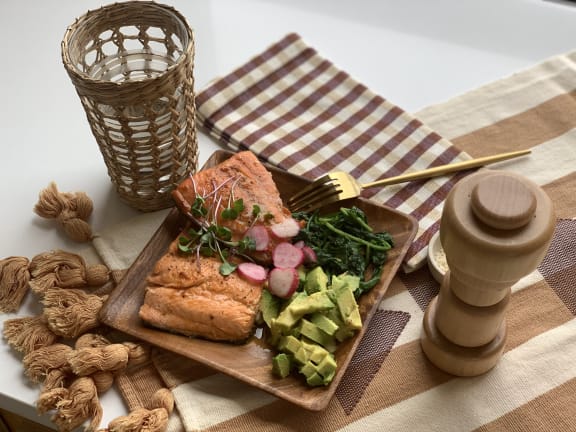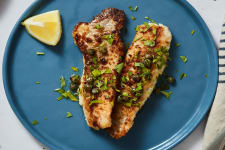Feeling like it’s time to elevate your wild Alaskan seafood experience in the kitchen? This go-to guide has all the information you need to troubleshoot what’s in the way of you making the best seafood of your life. Chances are you just need a little tweak in your technique.
Here are five common issues that home cooks encounter with their wild Alaskan seafood experience, and what you can do to address them — we’ll walk you through, every step of the way:
My Salmon is Coming Out Too Dry
No one likes to eat a dry fillet of salmon; even if it’s wild-caught, it’s not going to be great. In contrast, a perfectly cooked fillet of wild Alaskan salmon flakes easily with a fork into flavorful, tender pieces.
-
Are you having trouble achieving this perfection? Try reducing cook time by a few minutes. Wild Alaskan salmon is much leaner than its farmed counterparts, due to differences in diet and the conditions in which it spends its life. Being leaner makes it cook faster than farmed salmon, which are typically much higher in fat. You can learn more about these differences in our post about why wild salmon cooks faster than farmed.
-
Are you using recipes that you used to swear by, yet finding the salmon to be dry? Again, cut down on cook time. If a recipe doesn’t specifically ask for you to use wild salmon, more often than not it was designed with farmed salmon in the test kitchen. Check on doneness earlier than you are used to in order to find the sweet spot timing-wise, then make a note of this in your cookbook for future reference. If you’re not quite sure when wild salmon is done, you’ll want to read our post that tells you exactly what to look for no matter how you’re cooking your fish.
-
If you’re notorious for overcooking your proteins, cut yourself some slack by learning how to poach your salmon. Poaching any fish in liquid is a gentler method of cooking and will buy you a little wiggle room in terms of doneness. If you leave your fillet to poach a minute or two longer than you need to, it’s okay. You’ll still have a moist, flaky piece of salmon to enjoy after you remove it from the heat! You can dip your feet into the poaching fix by reading our post on how to poach wild salmon.
My Seafood Seems a Bit Slimy After Being Defrosted
Have you ever taken your defrosted seafood out of the fridge, only to find it feels a tad slimy? This is not a texture you want to have anywhere near your seafood, as it usually means it’s turning — no longer fresh.
Our seafood is always frozen shortly after it is pulled from the water. So, what went wrong before you were ready to cook your seafood? There are a few things that could be causing sliminess on your seafood after you thaw it, and fortunately they are all very easy to avoid.
-
Did you remove your seafood from its vacuum-sealed packaging or puncture the plastic before moving it into the refrigerator to thaw? If not, please refer to our post on how we recommend thawing all of our seafood, as this is step numero uno! Following this step ensures that your seafood will maintain its high-quality freshness.
-
Did you quick-thaw your seafood in a cool bowl of water, then cook promptly afterward? If not, you’ll want to coordinate your timing next time so that your seafood is thawed right when you’re ready to cook it. Don’t quick-thaw your seafood and then return it to the refrigerator raw for a later date, as it is more prone to going bad in the interim.
-
Did you thaw your seafood in the refrigerator the right way, then cook within 1-2 days of defrosting? If not, your seafood may have begun to turn. Using seafood within a brief but manageable window of time — within a day or two of defrosting — is highly recommended as seafood tends to go bad more quickly than meat or poultry.
I'm Finding Bones in My Fillet
When you’re eating fish, you’re bound to come across a bone at some point (no pun intended) when you least expect it. That’s just the nature of the beast. But that doesn’t make it any less unpleasant.
-
Did you find bones in your fillet of salmon? These are most likely pin bones that are not typically removed in processing due to the delicate nature of the task, which is even more delicate when you’re working with super fresh fillets. All you need to do is make sure to check for and remove any pin bones before cooking. Please consult our blog post on how to do this like a pro.
-
Did you find bones in your cod/halibut/rockfish/sablefish/pollock? These all should have been removed by our team during processing. Please let us know if you come across any bones in these fillets.
I Can’t Seem to Get Crispy Skin on my Salmon
Taking a crackling bite of crispy skin on a fillet of fish, seeing that golden crust perfectly formed on your pan-seared scallops — these are some of the greatest pleasures of eating. So why is your seafood not living up to its full potential?
-
Are you patting your seafood dry before cooking it, whether you’re searing, grilling, or broiling? This step is an absolute must. Read more about how to achieve crispy salmon skin in our blog post dedicated to this culinary art.
-
If you’re trying to get a pan-seared crisp, what type of pan are you using? Which oil are you cooking with? How much heat are you using? Again, refer to our post about how to achieve crispy skin to get the lowdown on how you adjust these factors in your favor.
-
Are you leaving your fillet alone as it cooks in the pan until it’s time to flip it? It might be tempting to move things around while they cook, but have patience! The skin will naturally release itself from the pan once it’s crisp, and then you can flip it to cook the other side.
-
By the way, are you starting your fish skin side down when you’re pan searing? If not, make it a habit to always cook the skin first.
-
If you’re broiling your skin-on fillets, are they positioned on the top rack of your oven? Moving them as close to the heat source as possible is key to getting crispy, charred skin. Read more about how to broil like a boss in our post dedicated to the technique.
My Seafood Always Sticks to the Pan or Grill
One of the most frustrating aspects of cooking fish is when everything looks so beautiful in the pan… until you go to flip it, shredding it to bits in the process.
-
Are you patting your seafood dry before cooking it? This step is an absolute must, as it allows your seafood to develop a protective crust that pulls away from the heat source rather than steaming and sticking to it.
-
Are you leaving your fillet alone as it cooks in the pan/on the grill until it’s time to flip? It might be tempting to move things around while they cook, but have patience! The surface of your seafood will naturally release itself from the heat source when it’s ready; then you can flip it to cook the other side.
-
By the way, are you starting your fish skin side down? If not, make it a habit to always cook the skin first, whether you’re cooking directly on grill grates or in a pan.
If you’re grilling seafood, are the grates of your grill clean and oiling them afterward? Having clean, lightly oiled grates is grilling 101. Check out our blog post with more tips on how to grill your seafood without having it stick to the grates.






